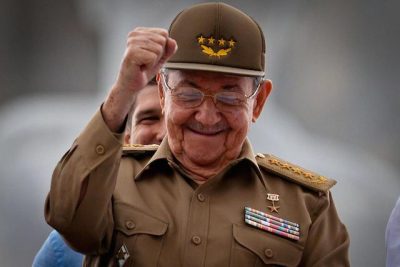Raul Castro steps aside in Cuba
After 10 years in office, Cuba’s Raul Castro, 86, will retire as president on Thursday.
Today the country’s after parliament proposed Miguel Diaz-Canel as his replacement, a shift that will usher in the island’s first non-Castro leader since the 1959 revolution.
Raul Castro announced his departure several years ago and has long signalled that Diaz-Canel, a 57-year-old Communist Party stalwart, was his likely successor, carefully managing the transition to ensure political continuity.
The move to a younger generation of Communist leaders is historic on an island dominated for nearly 60 years by Fidel Castro and then his brother Raul. But in the short term it is unlikely to herald major changes to the one-party system or state-dominated economic model.
The rubber-stamp National Assembly voted on the proposal to promote Diaz-Canel, who is currently first vice president.
His was the only name put forward by a party-backed commission, and was greeted with a long ovation from lawmakers.
Lawmakers will vote for 30 other members of Cuba’s state council as well as the president. The results will be announced and the new president will be sworn in on Thursday.
Although this week’s assembly is promoting younger government leaders, Castro and other elders of the revolution will retain considerable power in their roles as the top leaders of the Communist Party at least until a party congress set for 2021.
Political observers said Diaz-Canel would be given the job of breathing life into the creaking economy, but would seek Castro’s approval on major strategic decisions such as the relationship with the United States.
He is expected to be cautious at first, seeking to consolidate support among party conservatives despite desire among young Cubans for faster development. He is extremely unlikely to challenge one-party rule.
Diaz-Canel should “increase the speed of change in Cuba while preserving the good things,” said blogger Harold Cardenas, 32, adding that resistance from within the party to Castro’s economic reforms had held the country back.
After years climbing the ranks of the Communist Party, the future president is considered a safe bet to carry the mantle of Castro and other elderly leaders who helped Fidel Castro oust U.S.-backed dictator Fulgencio Batista.
Trained as an electrical engineer, Diaz-Canel embraces technology and appears socially liberal, but he is relatively unknown to ordinary Cubans.
He faces “myriad challenges on all fronts,” said Richard Feinberg, who led Latin America policy in former U.S. President Bill Clinton’s White House.
Cuba’s economy remains smaller per capita than it was in 1985, when it had the support of Communist ally, the Soviet Union, according to one study. It is suffering from a crisis in oil benefactor Venezuela. Relations with the United States are strained anew under President Donald Trump and Cuba has few allies in the region.
“Most Cubans, especially the young, await an unambiguous, decisive acceleration of market-opening reforms,” Feinberg said. “Strategically, Diaz-Canel must confront renewed hostility from the U.S. administration.”
Castro, who had served for decades as defence minister, became president in 2008 when Fidel Castro, his health failing, formally handed over power. Fidel Castro died in 2016 aged 90.
Shunning the long speeches his brother was famous for, Raul Castro kept his low-key style even as he reached a landmark agreement in 2014 with former U.S. President Barack Obama to restore diplomatic ties with the United States. Relations with Washington had been hostile since soon after Fidel Castro took the island on a sharply leftward path after the revolution.
While stressing he was acting to preserve and not dismantle socialism, Castro also introduced market reforms to one of the world’s last Soviet-style centrally planned economies, permitting more small businesses and encouraging some foreign investment.
He gave more freedoms to Cubans, allowing them to travel, visit resorts on the island previously reserved for foreigners and gradually increasing internet access, although opposition groups still face official harassment.
On Wednesday, Castro wore a dark suit in place of military fatigues and sat near Diaz-Canel as an official read out the names of proposed leaders to the 604 legislators gathered at a wood-paneled convention center in a quiet Havana suburb.
The legislators then cast secret ballots and were expected to almost unanimously support the slate.
One of the elders of the revolution, 85-year-old Ramiro Valdes, was proposed to the council of state, the country’s top executive body, a sign of caution in implementing the generational shift. Valdes has held senior posts since the 1960s.
The first vice president will be Salvador Valdes Mesa, who at 72 is between the two generations. He is seen as less reform-minded than the new president. He is the first Afro-Cuban to hold such high office in the government.
Cuba calls its political processes democratic. However, many ordinary Cubans say they feel distant from politics, preferring to focus on making ends meet within the limited economic opportunities that opened under Castro’s changes.
A few even call for political reform.
“Change would be good to give opportunities to the opposition, so that there are other parties and freer elections,” said Ruben, 51, a musician who did not want to give his full name for fear of reprisals.


